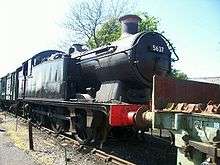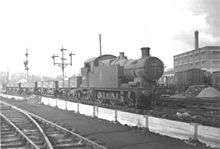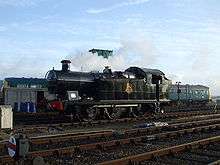GWR 5600 Class
| Great Western Railway 5600 class[1] | |||||||||||||||||||||||||||||||||
|---|---|---|---|---|---|---|---|---|---|---|---|---|---|---|---|---|---|---|---|---|---|---|---|---|---|---|---|---|---|---|---|---|---|
.jpg) 5619 at the Gloucestershire Warwickshire Railway | |||||||||||||||||||||||||||||||||
| |||||||||||||||||||||||||||||||||
| |||||||||||||||||||||||||||||||||
| |||||||||||||||||||||||||||||||||
| |||||||||||||||||||||||||||||||||


The GWR 5600 Class is a class of 0-6-2T steam locomotive built between 1924 and 1928. They were designed by C.B Collett for the Great Western Railway (GWR), and were introduced into traffic in 1924. After the 1923 grouping, Swindon inherited a large and variable collection of locomotives from historic Welsh railway companies, which did not fit into their standardisation programme. GWR boiler inspectors arrived en masse and condemned many of the original locomotives. The systematic destruction of many examples of locomotives, most still in serviceable condition, followed. Of the Taff Vale Railway, many engines continued to operate up to the 1950s, but today only two locomotives survived, TVR 'O1' No.28, the last-surviving Welsh-built engine, and TVR 'O2' No.85.
Two hundred GWR 5600 class replacement locomotives were built and remained in service until withdrawn by British Railways between 1962 and 1965. Nine of the class have survived into preservation.
Background: Welsh 0-6-2T types
The railways of South Wales seem to have had a particular liking for the 0-6-2T type. This was because the nature of the work they undertook demanded high adhesive weight, plenty of power with good braking ability, but no need for outright speed, nor large tanks or bunker as the distances from pit to port were short. The 0-6-2 configuration was discovered to confidently handle the sharp curves so prevalent in the area. These Welsh locomotives were taken over by the GWR at The Grouping in 1923 and some were rebuilt with GWR taper boilers. A number of them passed into British Railways (BR) ownership in 1948, including (with some gaps in numbering):
- Brecon and Merthyr Railway, BR numbers 431-436
- Cardiff Railway, BR number 155
- Rhymney Railway, BR numbers 35-83
- Taff Vale Railway, BR numbers 204-399
For further information on these pre-grouping locomotives see Locomotives of the Great Western Railway.
Origins
When the GWR took over the Welsh valley lines, they discovered that the Welsh locomotive crews liked their 0-6-2T locomotives. Rather than a new design the 5600 Class was a "Swindonised" version of the Rhymney Railway M class and R class locomotives. The 1904 M class (and the similar 1909 R class) were successful designs ideally suited to hauling heavy coal trains a relatively short distance.
The 5600 Class was specially designed for work in South Wales, replacing the elderly, worn-out locomotives that had been 'inherited' in 1923, when the smaller railway companies were forcibly merged into the GWR at The Grouping. Contrary to this trend, the Rhymney Railway's more modern 0-6-2s were in generally good order and had proved successful. Thus they became the blueprint for the 56xx.
The first of five R class locos was re-boilered by the GWR in 1926 and a single M class was upgraded in 1930. In this form, both were visually almost indistinguishable from the 56 Class.
Design
The design of the 5600 Class followed Great Western Railway practice as far as possible, by utilising many standardised parts. Included in Collett's innovations was a Standard Number 2 boiler which was suitable for the 5600 Class, and the M and R class Rhymney locomotives, complete with the traditional brass GWR safety valve casing and copper-capped chimney.
They were substantial sized tank engines, 37 ft 6ins in length and weighing 62 tons. The side tanks were capable of holding 1900 gallons of water. The high domed cab, bunker and tanks were closely related to the 31xx and 42xx classes. One hundred of the class were built at the GWR workshops in Swindon from 1924-1927.
In 1927 another 100 similar engines were constructed – these were slightly heavier and numbered in the 66xx series. Nos 6600-6649 were Swindon-built in 1927-1928, but due to the pressure of work 6650-6699 were built by Armstrong Whitworth in 1928. This resulted in some minor design differences from the Swindon locomotives.
While they were powerful machines, the 5600s were very unpopular with footplate crews at the time. They were beset by numerous failures, the most common of which was hot axle boxes. They lacked the wider tolerances in their boxes that the original Welsh company locomotives had. They also had the tendency to derail, so those driving them preferred them in reverse, where the pony truck was able to guide them around tight curves. When the Welsh railwaymen discovered that the new GWR 5700 Class 0-6-0 pannier tank (introduced 1929) was even more suitable for the same work – being shorter and lighter, with roughly the same (slightly lower) tractive effort – no further Class 56xx/66xx locos were built.[2]
The 5600 Class had the distinction of being the only locomotive of 0-6-2 wheel arrangement built new by the GWR. Nevertheless, there were just over 400 locos with that wheel arrangement in service from 1940–1945, demonstrating the large number acquired in 1923.
Dimensions
Service
A fall in the South Wales coal trade in the 1930s saw many of the class re-allocated to other parts of the system. Due to the stability of the design, many drivers would typically operate the 56xx class down the Welsh valleys in reverse (bunker first). The placement of the trailing wheels helped the engine enter the curves better than if operated in the other direction. Typically, during operation, when pulling a heavy load the tanks were operated bunker first, and then smokebox first on the return trips up the valleys.[4]
All the 56xx/66xx locomotives passed into British Railways ownership at nationalisation in 1948, and all remained in service until 1962, at which time they were withdrawn from service quite rapidly, with the onset of diesel traction on BR gaining momentum. All had been retired by 1965.
Preservation

Several ended up in Woodham Brothers' scrapyard in Barry, South Wales, with eight of the nine preserved engines saved from Barry. The majority of the class in preservation were built at Swindon Works, three of them: 6686, 6695 & 6697 being built by Armstrong Whitworth.
As the locomotives were operated mainly in South Wales, some railfans know the Class by the nickname "Taffy Tank";[5][6] 'Taffy' being a derogatory term for someone of Welsh descent. However, the 56xx class never had this title officially, whereas the more typical examples of the Rhymney Railway's M and R classes they replaced, were arguably the original 'Taffy Tanks' of fame.
As of 2017 6 of the class have run in preservation with 3 classmembers currently in operation, 5668 is currently undergoing restoration from scrapyard condition at the Kent and East Sussex Railway, 6634 and 6686 are both awaiting restoration from scrapyard condition at Peak Rail and The Barry Tourist Railway's & 6697 is on static display at Didcot Railway Centre.
The following table lists the Preserved locomotives:
| Number | Builder | Built | Withdrawn | Working Life | Current Location | Current Status | Notes |
|---|---|---|---|---|---|---|---|
| 5619 | Swindon Works | March 1925 | June 1964 | 39 Years, 3 months | Nene Valley Railway | In Service | In BR unlined Black, owned by the Telford Steam Railway. currently on hire to the Nene Valley Railway. |
| 5637 | Swindon Works | September 1925 | June 1964 | 38 Years, 9 months | East Somerset Railway | In Service | In BR lined Green, owned by the 5637 Steam Loco Group |
| 5643 | Swindon Works | October 1925 | July 1963 | 37 Years, 9 months | Embsay & Bolton Abbey Railway | In Service | In BR lined Green, owned by the Furness Railway Trust. Based at the Ribble Steam Railway but currently out on loan. |
| 5668 | Swindon Works | June 1926 | September 1964 | 38 Years, 3 months | Kent & East Sussex Railway | Awaiting Restoration | Privately owned. Asbestos stripped in readiness for a boiler lift |
| 6619 | Swindon Works | January 1928 | March 1963 | 35 Years, 1 month | Kent & East Sussex Railway | Awaiting Overhaul. | In BR unlined Black. Owned by 6619 Ltd. Boiler Ticket Expired 1 January 2015. |
| 6634 | Swindon Works | August 1928 | June 1964 | 35 Years, 8 months | Peak Rail | Under Restoration | Owned by Pete Waterman. Restoration was to be undertook by the SVR but never commenced, moved to Rowsley in Nov 2017. |
| 6686 | Armstrong Whitworth | October 1928 | June 1964 | 35 Years, 6 months | Barry Tourist Railway | Awaiting Restoration | Owned by the Vale of Glamorgan Council as part of the Barry Ten |
| 6695 | Armstrong Whitworth | October 1928 | July 1964 | 35 Years, 9 months | West Somerset Railway | Undergoing Overhaul | In BR lined Green, formerly based at Swanage Railway but undergoing Overhaul and repairs at WSR after low loader incident where the trailer collapsed. |
| 6697 | Armstrong Whitworth | October 1928 | May 1966 | 37 Years, 7 months | Didcot Railway Centre | On Static Display | In GWR unlined Green, only member of the Class not to go through Woodham Brothers' scrapyard |
References
- 1 2 3 Casserley, H. C. (1955 (Revised ed. 1960)). The Observer's Book of Railway Locomotives of Britain. Frederick Warne. p. 56. Check date values in:
|date=(help) - ↑ http://cdn.steampowered.com/Manuals/65222/56xx%20Locomotive%20Addon.pdf
- ↑ le Fleming, H.M. (April 1958). White, D.E., ed. Part 5: Six-coupled Tank Engines. The Locomotives of the Great Western Railway. RCTS. p. E75.
- ↑ Haresnape, Brian (1978). Collett & Hawksworth Locomotives: A Pictorial History. Shepperton: Ian Allan. p. 38. ISBN 0-7110-0869-8.
- ↑ Morgan, Keith (2002-02-17). "Latest progress on GWR Taffy Tank No. 6695 at Herston Works, Swanage". (Swanage Railway News Gallery - Page 118). Swanage Railway. Missing or empty
|url=(help) - ↑ "Saved loco pulls passengers again". BBC News online. 13 February 2006. Retrieved 10 January 2010.
External links
| Wikimedia Commons has media related to GWR 5600 Class. |
- 5600 class (Great Western Archive)
- No. 5637 (5637 Steam Locomotive Group)
- No. 5643 (Furness Railway Trust)
- No. 6619 (Kent & East Sussex Railway)
- No. 6695 (Swanage Railway)